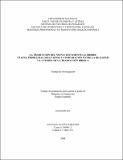| dc.contributor.author | Acuña Naranjo, Natalia | |
| dc.date.accessioned | 2020-07-01T21:56:44Z | |
| dc.date.available | 2020-07-01T21:56:44Z | |
| dc.date.issued | 2008 | |
| dc.identifier.uri | http://hdl.handle.net/11056/17693 | |
| dc.description.abstract | El presente trabajo de investigación describe y explica un proceso de traducción bíblica
a la lengua indígena costarricense bribri que tardó cuarenta y siete años en completarse. En él
se detalla las cuatro etapas que lo conformaron: adaptación cultural de los traductores,
creación de la lengua escrita bribri, traducción de los libros bíblicos del Nuevo Testamento y
la impresión y la distribución de los ejemplares.
También se presenta una descripción de los problemas más representativos enfrentados
por los traductores, así como la forma en que los solucionaron. Además, se expone en cada
capítulo una serie de herramientas y sugerencias basadas en este proceso de traducción para
ser utilizadas por un futuro traductor bíblico.
Cada capítulo concluye con una comparación entre la teoría de traducción aplicada a los
textos bíblicos desde la perspectiva de Jean Claude Margot y el modelo de traducción
desarrollado por el Summer Institute of Linguistics con la realidad experimentada por los
participantes de este proceso para así analizar hasta qué grado la teoría y la realidad coinciden.
Por último, este trabajo expone una serie de consideraciones finales y recomendaciones
que sirven de base para futuros trabajos de graduación e investigaciones. | es_ES |
| dc.description.abstract | This research project describes and explains a Bible translation process to Bribri, a Costa
Rican Indian language, which lasted forty seven years to be completed. This study gives
details about the four stages of this process: cultural adaptation of the translators involved,
creation of the written Bribri, translation of the New Testament books and finally the printing
and distribution of copies.
It also describes the most representative problems that the translators faced, as well as
the ways they solved them. Moreover, each chapter presents tools and suggestions based on
this translation process that could be used for future Bible translators responsible for a similar
project. Each chapter also compares the translation theory applied to Biblical texts from the
perspective of Jean Claude Margot and the translation model developed by the Summer
Institute of Linguistics with the reality experienced by the participants of this project and thus
analyzes up to which grade theory and reality converged. Lastly, this work shows some final
considerations and recommendations that can be used as a base for future graduation projects
and research. | es_ES |
| dc.description.sponsorship | Universidad Nacional, Costa Rica | es_ES |
| dc.language.iso | spa | es_ES |
| dc.publisher | Universidad Nacional, Costa Rica | es_ES |
| dc.rights | Acceso abierto | es_ES |
| dc.rights | Attribution-NonCommercial-NoDerivatives 4.0 Internacional | * |
| dc.rights.uri | http://creativecommons.org/licenses/by-nc-nd/4.0/ | * |
| dc.subject | SAGRADAS ESCRITURAS | es_ES |
| dc.subject | NUEVO TESTAMENTO | es_ES |
| dc.subject | TRADUCCIÓN | es_ES |
| dc.subject | LENGUAS ABORÍGENES | es_ES |
| dc.subject | BRIBRIS (PUEBLO INDÍGENA CENTROAMERICANO) | es_ES |
| dc.subject | COSTA RICA | es_ES |
| dc.subject | HOLY WRITINGS | es_ES |
| dc.subject | NEW TESTAMENT | es_ES |
| dc.subject | TRANSLATION | es_ES |
| dc.subject | ABORIGINAL LANGUAGES | es_ES |
| dc.subject | BRIBRIS (CENTRAL AMERICAN INDIGENOUS PEOPLE) | es_ES |
| dc.title | La traducción del nuevo testamento al Bribri etapas, problemas, soluciones y comparación entre la realidad y la teoría de la traducción bíblica. | es_ES |
| dc.type | http://purl.org/coar/resource_type/c_bdcc | es_ES |
| una.tesis.numero | 225.802979 A189t | es_ES |
| dc.description.procedence | Escuela de Literatura y Ciencias del Lenguaje | es_ES |


